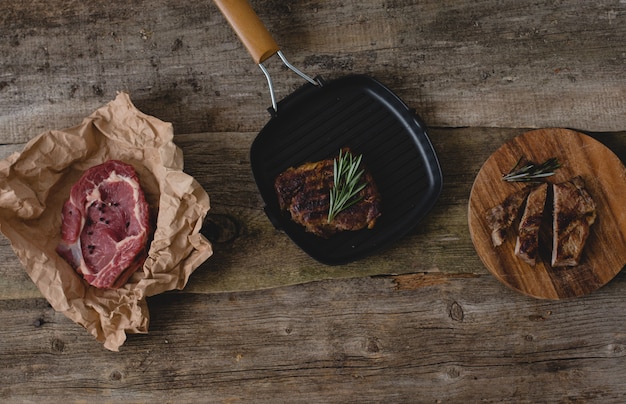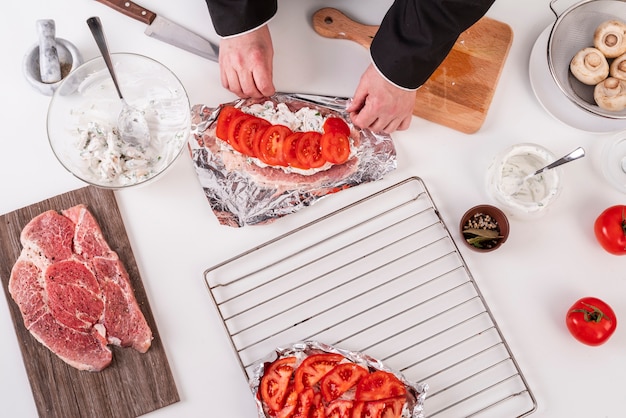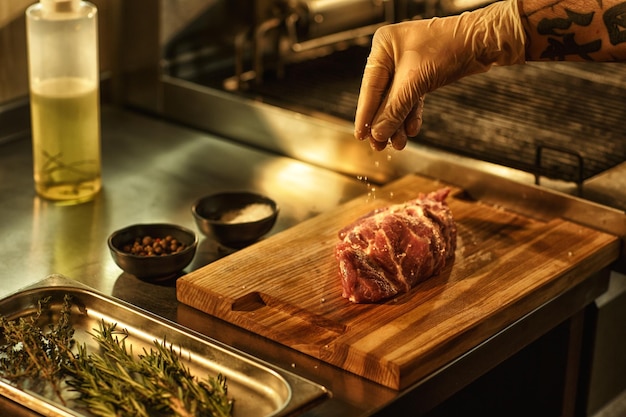Let's face it, there's something undeniably satisfying about a perfectly cooked steak. And when it comes to top sirloin, you're talking about a cut that's both delicious and versatile. It's got that beautiful marbling that gives it a rich, juicy flavor, and its firmness makes it perfect for grilling, pan-searing, or even roasting. But let's be honest, getting a steak perfectly cooked can feel like a culinary gamble sometimes. Overcooked, dry, tough – those are the nightmares that haunt even the most seasoned home cooks. But fret no more! I've spent years perfecting my steak game, and I'm here to share all my secrets, from choosing the right cut to nailing the perfect sear. Get ready to level up your steak skills, because by the end of this guide, you'll be cooking top sirloin like a pro.
(Part 1) choosing the right steak

You wouldn't start building a house without the right foundation, would you? The same goes for cooking a great steak. It all starts with picking a top-notch piece of meat. Think of it like this: you're investing in a delicious experience, and the right cut is your first step towards a successful steak dinner. Here's what you need to know when choosing your top sirloin:
Marbling: The Key to Juiciness
Imagine a piece of steak dotted with little white specks. Those are fat deposits, and they're the secret to juicy, tender steak. The more marbling you see, the more flavor and moisture your steak will have. Think of it as a delicious network of flavor highways throughout your steak. Don't be shy about asking your butcher for advice on finding a well-marbled cut. They're the experts, and they'll happily guide you towards the perfect piece of meat.
Thickness Matters
For top sirloin, aim for a steak that's at least 1 inch thick. Any thinner, and you'll be fighting a losing battle against overcooking. A thinner cut will cook too quickly, resulting in a dry and chewy experience. Now, if you've got a thinner cut on hand, don't despair! We'll talk about how to cook those later on in the guide.
The "Meat" Test: A Quick Check for Freshness
Here's a handy trick I learned from my dad, a seasoned grill master himself. Gently press your finger into the meat. If it springs back quickly, it's fresh and firm, a sign of a steak that's ready to impress. If it leaves an indent, it might be a bit older, but not necessarily bad. It's all about preference, and you can still cook a great steak from a slightly older cut.
(Part 2) Prepping Your Steak for Success

You've got your top sirloin, now it's time to get it prepped for its culinary debut. These simple steps are the foundation for a steak that's both flavorful and visually appealing.
Pat It Dry: Moisture is the Enemy
The first step is to pat your steak dry with paper towels. Excess moisture can lead to steaming instead of searing, hindering that beautiful crust we're aiming for. Think of it as prepping your steak for a perfect tan – a dry surface will ensure a crispy, golden brown exterior.
Room Temperature: Bringing Out the Best
You wouldn't jump into a freezing cold pool, would you? Neither does your steak. Bringing it to room temperature before cooking ensures even cooking and prevents cold shock when it hits the hot pan. I usually give my steak about 30 minutes to come up to temp.
Seasoning: Enhancing the Natural Flavors
Now, this is where the real fun begins – seasoning! This is your chance to let your personal preferences shine. I'm a minimalist when it comes to steak. Salt and pepper, good quality ones, of course, are my go-to. You can also add other herbs and spices, like garlic powder, onion powder, or paprika, but remember, less is more.
Experiment, But Don't Overdo It
Remember that time I tried to make a "fancy" steak with a complex rub? It ended up tasting like a spice rack exploded. Trust me, you want to enhance the natural flavors of the steak, not mask them. A sprinkle of salt and pepper goes a long way, and you can always add a little extra flavor at the end with a simple pan sauce.
(Part 3) Choosing Your Cooking Method: Searing, Grilling, or reverse searing?

Now, we're getting to the heart of the matter – the cooking method. Top sirloin is incredibly versatile, and it can be cooked using a variety of techniques. Here's a breakdown of some popular methods, along with their pros and cons.
Pan-Searing: Quick, Easy, and Delicious
This is my go-to method for its simplicity and impressive results. You'll need a heavy-bottomed pan, preferably cast iron, and some high-quality oil. Heat the oil over medium-high heat until it's shimmering, then carefully place your steak in the pan. Make sure you don't overcrowd the pan, giving each steak space to cook evenly. Let it cook for 2-3 minutes per side, or until you get a nice, crispy sear. For a perfectly cooked steak, you can then transfer it to the oven for a few minutes to finish cooking, if desired.
Grilling: The Ultimate Smoky Flavor
Grilling gives you that unmistakable smoky flavor that elevates any steak experience. Get your grill nice and hot, preferably with charcoal. Place the steak on the grill and cook for 2-3 minutes per side, or until you get a good char. Then, reduce the heat and cook for a few more minutes, turning occasionally, until the steak reaches your desired level of doneness.
Reverse Searing: Tender and Juicy, Every Time
This method is a game-changer for those who want a perfectly cooked steak that's both tender and juicy. It involves cooking the steak in a low oven first, then finishing it off with a sizzling sear in a hot pan. Preheat your oven to 250 degrees Fahrenheit, place the steak on a baking sheet, and cook for about 30 minutes. Then, remove the steak from the oven, heat a pan over medium-high heat, and sear the steak for 1-2 minutes per side. The result? A steak that's cooked evenly throughout, with a delicious, flavorful crust.
(Part 4) Mastering the Art of Doneness: From Rare to Well Done
Here's where things get serious – understanding doneness is key to achieving the perfect steak. But don't rely on guesswork, invest in a good meat thermometer. It's your best friend in the kitchen, especially when it comes to steak. Here's a quick guide to different levels of doneness:
Rare: Cool to the Touch, Slightly Red Center
125-130 degrees Fahrenheit. The steak will be cool to the touch in the center and will have a slightly red hue. Think of it as a gentle kiss from the heat.
Medium-Rare: Warm to the Touch, Slightly Pink Center
130-135 degrees Fahrenheit. The steak will be warm to the touch in the center and will have a slightly pink hue. This is a popular choice for those who like a bit more "pink" in their steak.
Medium: Warm to the Touch, Faint Pink Hue
135-140 degrees Fahrenheit. The steak will be warm to the touch in the center and will have a faint pink hue. This is a good middle ground for those who prefer a more cooked steak but still want some tenderness.
Medium-Well: Warm to the Touch, Slight Brown Hue
140-145 degrees Fahrenheit. The steak will be warm to the touch in the center and will have a slight brown hue. This is a safe bet for those who prefer a more well-cooked steak.
Well Done: Hot to the Touch, Fully Browned
145-150 degrees Fahrenheit. The steak will be hot to the touch in the center and will be fully brown. This level of doneness results in a steak that's cooked through and through, but it can also be a bit dry and tough.
(Part 5) The Importance of Resting: Let the Steak Recover
You've cooked your steak, it's reached your desired doneness, now what? Don't go slicing into it just yet! Let it rest. Giving your steak a good 5-10 minutes to rest is crucial for a delicious and juicy outcome.
How to Rest Your Steak Properly
Simply transfer your cooked steak to a cutting board and loosely cover it with foil. You want to trap the heat and moisture, but not steam it. Resist the urge to cut into it prematurely. During this resting period, the juices will redistribute throughout the steak, resulting in a much more tender and flavorful bite.
(Part 6) Slicing It Up: Against the Grain for Tenderness
Ok, so you've let your steak rest, now it's time to slice it up. This might seem like a simple step, but it's crucial for maximizing tenderness. You want to slice against the grain. Think of the muscle fibers in the steak as running in a certain direction. You want to cut perpendicular to those fibers, resulting in a tender and satisfying bite.
Tips for Perfect Slicing
Start by cutting your steak in half lengthwise, then slice across the grain into thin strips. Use a sharp chef's knife or a steak knife for clean, even cuts. Avoid jagged edges, they can make the steak feel tough and less enjoyable.
(Part 7) Serving Your Perfect Top Sirloin Steak: A Culinary Masterpiece
You've cooked your steak to perfection. Now it's time to present it in a way that's both delicious and visually appealing. Think of it as the finishing touches on a masterpiece.
side dishes: Complements to Your Steak
Steak shines with classic side dishes like mashed potatoes, asparagus, creamed spinach, or a simple salad. Choose dishes that complement the flavors of the steak and create a balanced, satisfying meal.
Sauces: A Touch of Flavor and Finesse
Some prefer their steak au naturel, but I'm a sauce person, no doubt about it. A simple pan sauce made with butter, garlic, and herbs can elevate your steak to new heights. Or, if you're feeling adventurous, try a red wine reduction or a peppercorn sauce. Remember, it's all about personal taste and what you find delicious.
(Part 8) Storage and Leftovers: Making the Most of Your Steak
You've cooked a perfect steak, but what about those leftovers? Or, maybe you're prepping your steak ahead of time? Here's what you need to know about storage and reheating.
Storage: Keeping Your Steak Fresh
To store your cooked steak, simply wrap it tightly in plastic wrap and refrigerate it for up to 3-4 days. This will help preserve its flavor and texture.
Reheating: Bringing Back the Flavor
The best way to reheat leftover steak is in a preheated oven at 350 degrees fahrenheit for about 10-15 minutes. You can also reheat it in a skillet on the stovetop, but watch out for overcooking.
(Part 9) FAQs: Common Steak Questions Answered
You've got your questions, I've got the answers. Here's a quick rundown of some common questions about cooking top sirloin steak.
What if My Steak is Too Thin?
Don't worry, you can still cook a thin steak to perfection! Simply cook it for a shorter amount of time, or use the reverse searing method to ensure it's cooked evenly.
What if My Steak is Overcooked?
There's no magic fix for overcooked steak, but you can still salvage it. Slice it into thin strips and use it in a stir-fry, fajitas, or a flavorful salad.
How Do I Know if My Steak is Done Without a Thermometer?
You can use the "finger test" – press the steak and feel the firmness. Rare will be very soft, medium-rare will be slightly springy, medium will be firm, and well done will be very firm. But remember, a thermometer is your best bet for accuracy.
What Are Some Good Sides to Serve with Top Sirloin Steak?
Classic sides like mashed potatoes, asparagus, creamed spinach, and a simple salad are always a good choice. But you can also get creative with roasted vegetables, cheesy pasta dishes, or a flavorful risotto.
What's the Best Way to Clean My cast iron pan?
Wash your cast iron pan with hot water and a little bit of soap. Don't use harsh cleaners or steel wool, as they can damage the pan. Dry it thoroughly and lightly oil it before storing it.
(Part 10) Final Thoughts: Embracing the Journey of Steak
There you have it, my guide to cooking the perfect top sirloin steak. It's all about choosing the right cut, prepping it properly, using the right cooking method, and understanding doneness. But most importantly, it's about enjoying the process. Don't be afraid to try new things, make mistakes, and learn from them. That's what cooking is all about, a journey of discovery and deliciousness. Now, I'm off to fire up the grill and cook myself a perfect steak. Cheers!
Everyone is watching

How to Cook Frozen Lobster Tails Perfectly: A Step-by-Step Guide
RecipesLobster. Just the word conjures up images of lavish meals, special occasions, and a taste of luxury. But let's...

Pigs in a Blanket Cooking Time: How Long to Bake for Perfect Results
RecipesAh, pigs in a blanket. Just the name conjures up images of those delightful little parcels of crispy pastry en...

Pork Fillet Cooking Time: How Long to Cook It Perfectly
RecipesPork fillet, or tenderloin as it's sometimes called, is a real favourite in our house. It's so versatile, and...

The Ultimate Guide to Tender, Juicy Pulled Pork
RecipesRight, let's talk pulled pork. It's one of those dishes that just screams "comfort food," doesn't it? I mean...

The Ultimate Guide to Cooking Delicious Frankfurters
RecipesLet's face it, we all love a good frankfurter. It's a classic, simple, and always satisfying. But let's be rea...
